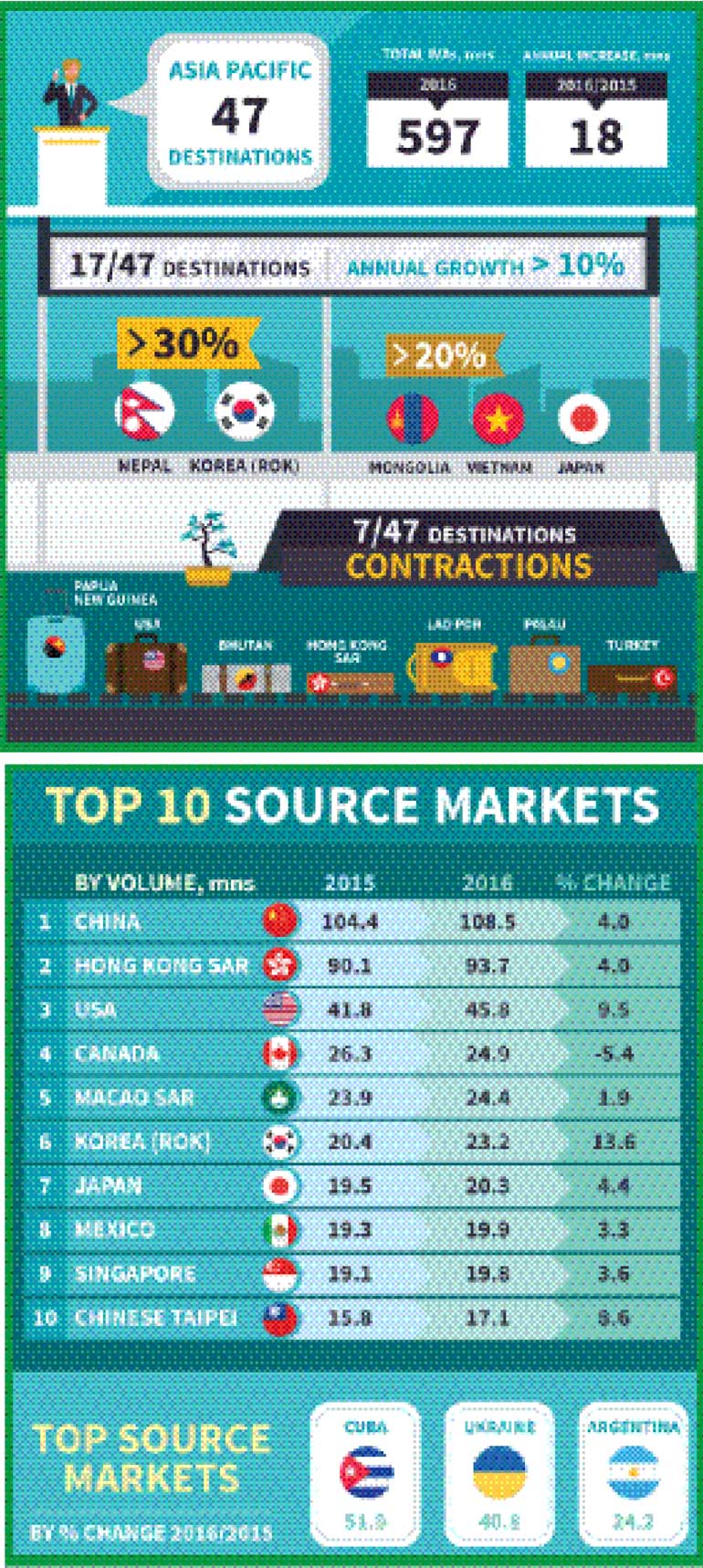Sunday Mar 16, 2025
Sunday Mar 16, 2025
Wednesday, 17 May 2017 00:08 - - {{hitsCtrl.values.hits}}
 PATA’s Annual Travel Monitor for 2017 – Early Edition, released today, shows an annual increase of three% in foreign arrivals into 47 Asia Pacific destinations for 2016 to record an aggregate inbound count of close to 600 million.
PATA’s Annual Travel Monitor for 2017 – Early Edition, released today, shows an annual increase of three% in foreign arrivals into 47 Asia Pacific destinations for 2016 to record an aggregate inbound count of close to 600 million.
Despite the significant challenges being faced by Turkey’s tourism sector the annual net increase in arrivals into the Asia Pacific region was still strong, adding close to 18 million additional arrivals to its total foreign inbound count year-on-year.
Seventeen of those destinations had double-digit growth rates ranging from more than 30% for Nepal and Korea (ROK) and over 20% for each of Mongolia, Japan and Vietnam. Growth was once again uneven with seven Asia Pacific reporting contractions in foreign arrivals in 2016 compared to 2015.
The strongest destination sub-regions for annual growth between 2015 and 2016 were South America with an annual increase of over 13%, Oceania with a gain of more than 11% and South Asia with close to 10% growth.
Across the three major regions with Asia Pacific, Asia was the front runner for foreign arrivals by volume with almost 436 million international arrivals (70%), followed by the Americas with close to 147 million arrivals (34%) and the Pacific with 24.5 million international arrivals (12%).
Intra-regional travel flows were extremely strong for Asia and the Americas with 94% and 78% respectively of their inbound volumes arising from within the same region. The Pacific was the only destination region to see the majority of its arrivals come from outside that region; more than 52% of foreign arrivals into the Pacific in 2016 came from Asia as opposed to the Pacific which generated 32% of the inbound arrivals to that region.
Origin markets in Northeast Asia were the largest generators of absolute volumes into Asia Pacific in 2016, led by China and Hong Kong SAR which generated 108.5 million and 93.7 million arrivals respectively. These were supported by Macao SAR, which generated 24.4 million arrivals as well as Korea (ROK) with 23.2 million, Japan with 20.3 million and Chinese Taipei with 19.8 million arrivals originating in those markets.
The USA, Canada and Mexico also rated within the top ten generators of foreign arrivals in 2016, producing 45.8 million, 24.9 million and 20.3 million arrivals respectively into Asia Pacific in that year.
Singapore was the only Southeast Asian origin market within the top ten listing, generating close to 19.9 million arrivals for the year.
There were some very strong annual growth increases from a number of origin markets such as Cuba (+52%), Ukraine (+41%) and Argentina (+24%).
Similarly for a number of origin sub-regions, each of which added significant incremental volumes to the absolute count into Asia Pacific destination sub-regions between 2015 and 2016. Northeast Asia topped that list with an additional eight million arrivals within its own sub-region, and 4.4 million additional arrivals into Southeast Asia.
The reverse was also true with Southeast Asia generating 2.2 million and 1.8 million additional foreign arrivals into Northeast Asia and Southeast Asia itself respectively while in the Americas it was North America into Central America that rated highly, adding more than 1.2 million additional arrivals between 2015 and 2016.
“The year was one of strong overall growth and even stronger increases for some sub-regions and individual destinations. Clearly the volume is there but the destinations winning and losing fluctuate frequently and rapidly,” said PATA CEO Dr. Mario Hardy.
“The speed with which origin markets move and shift from one year to the next and from one destination to the next, highlights the importance of having clear and reliable measures of tourism movements into and across the Asia Pacific region. We are in an age where solid marketing metrics are essential to guide strategic decisions and identify appropriate resource deployment alternatives while reducing, simultaneously, risk and bolstering our ability to capitalise upon swiftly emerging opportunities.”
Discover Kapruka, the leading online shopping platform in Sri Lanka, where you can conveniently send Gifts and Flowers to your loved ones for any event including Valentine ’s Day. Explore a wide range of popular Shopping Categories on Kapruka, including Toys, Groceries, Electronics, Birthday Cakes, Fruits, Chocolates, Flower Bouquets, Clothing, Watches, Lingerie, Gift Sets and Jewellery. Also if you’re interested in selling with Kapruka, Partner Central by Kapruka is the best solution to start with. Moreover, through Kapruka Global Shop, you can also enjoy the convenience of purchasing products from renowned platforms like Amazon and eBay and have them delivered to Sri Lanka.
Discover Kapruka, the leading online shopping platform in Sri Lanka, where you can conveniently send Gifts and Flowers to your loved ones for any event including Valentine ’s Day. Explore a wide range of popular Shopping Categories on Kapruka, including Toys, Groceries, Electronics, Birthday Cakes, Fruits, Chocolates, Flower Bouquets, Clothing, Watches, Lingerie, Gift Sets and Jewellery. Also if you’re interested in selling with Kapruka, Partner Central by Kapruka is the best solution to start with. Moreover, through Kapruka Global Shop, you can also enjoy the convenience of purchasing products from renowned platforms like Amazon and eBay and have them delivered to Sri Lanka.